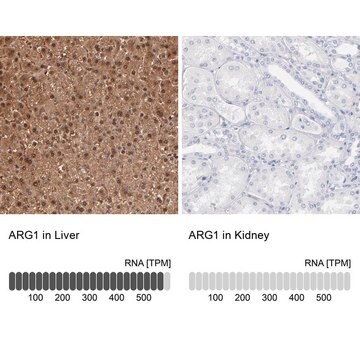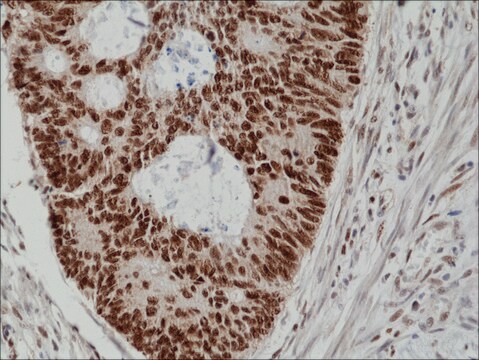310M-2
Parathyroid Hormone (PTH) (MRQ-31) Mouse Monoclonal Antibody
About This Item
Produtos recomendados
fonte biológica
mouse
Nível de qualidade
100
500
conjugado
unconjugated
forma do anticorpo
culture supernatant
tipo de produto de anticorpo
primary antibodies
clone
MRQ-31, monoclonal
descrição
For In Vitro Diagnostic Use in Select Regions (See Chart)
forma
buffered aqueous solution
reatividade de espécies
human
embalagem
vial of 0.1 mL concentrate (310M-24)
vial of 0.5 mL concentrate (310M-25)
bottle of 1.0 mL predilute (310M-27)
vial of 1.0 mL concentrate (310M-26)
bottle of 7.0 mL predilute (310M-28)
fabricante/nome comercial
Cell Marque™
técnica(s)
immunohistochemistry (formalin-fixed, paraffin-embedded sections): 1:100-1:500
Isotipo
IgG2a
controle
parathyroid tissue
Condições de expedição
wet ice
temperatura de armazenamento
2-8°C
visualização
cytoplasmic
Informações sobre genes
human ... PTH(5741)
Descrição geral
Surgical pathologists are familiar with the ability of parathyroid proliferations to assume a variety of histological guises, posing difficulty to categorize any given lesion as hyperplastic, adenomatous or carcinomatous in nature (Wick et al, 1997). This is usually resolved with macroscopic appearance of the remaining parathyroid glands as assessed by the surgeon. The role of the surgical pathologist is to identify the lesion as parathyroid in nature and to assess whether it is normocellular or hypercellular. Although easily accomplished in the majority of instances, rare examples of parathyroid hyperplasia/adenoma showing a follicular/trabecular arrangement may cause concern over the alternative diagnosis of a thyroid adenoma. This becomes more pertinent when the parathyroid lesion abuts into the thyroid gland or lies within the thyroid capsule. Immunostaining for thyroglobulin and parathyroid hormone (PTH) is especially useful to resolve the problem (Permanetter et al, 1983). Nevertheless, caution should be exercised since parathyroid cells often discharge their hormonal product almost as soon as it is packaged in the cytoplasm, resulting in false-negative anti-PTH immunostaining, although the cells are biologically synthetic (Wick et al, 1997)
Anti-PTH antibody is also useful to distinguish parathyroid hyperplasia/neoplasms from thyroid and metastatic neoplasms (Wick et al, 1997); although the pathologist is typically aware of the preoperative hypercalcemic status. Occasionally when the surgeon does not supply this information PTH immunohistochemistry is essential. Even more problematic, are situations in which clear cell parathyroid carcinomas are nonsecretory without an abnormality in mineral metabolism (Aldinger et al, 1982). In such situations, metastatic renal cell carcinoma or metastatic clear cell carcinoma of the lung is evident warranting PTH immunohistochemistry to arrive at the correct diagnosis (Wick et al, 1997). The other instance in which anti-PTH antibodies are useful is in the consideration of parathyroid carcinomas located primarily in the anterior mediastinum (intrathymically). In this situation distinction from primary thymic metastatic carcinomas, non-Hodgkin′s lymphoma and germ cell tumors is necessary (Murphy et al, 1986).
The diagnosis of the majority of parathyroid proliferation may be accomplished with an adequate history, biochemistry profile, and histomorphological assessment; however, rare instances in which the tumors have an abnormal location, clear cell morphology, or a non-secretory may result in erroneous diagnoses, warranting anti-PTH immunohistochemistry.
Qualidade
 IVD |  IVD |  IVD |  RUO |
Ligação
forma física
Nota de preparo
Outras notas
Informações legais
Não está encontrando o produto certo?
Experimente o nosso Ferramenta de seleção de produtos.
Código de classe de armazenamento
12 - Non Combustible Liquids
Classe de risco de água (WGK)
WGK 2
Ponto de fulgor (°F)
Not applicable
Ponto de fulgor (°C)
Not applicable
Certificados de análise (COA)
Busque Certificados de análise (COA) digitando o Número do Lote do produto. Os números de lote e remessa podem ser encontrados no rótulo de um produto após a palavra “Lot” ou “Batch”.
Já possui este produto?
Encontre a documentação dos produtos que você adquiriu recentemente na biblioteca de documentos.
Nossa equipe de cientistas tem experiência em todas as áreas de pesquisa, incluindo Life Sciences, ciência de materiais, síntese química, cromatografia, química analítica e muitas outras.
Entre em contato com a assistência técnica




